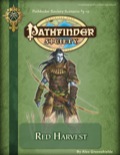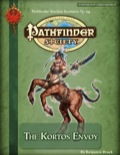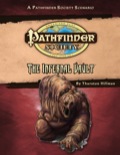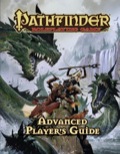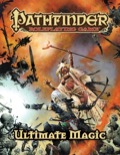Sign in to create or edit a product review. This scenario was an opportunity to look into Nagaji society and after playing it I must say that I'm not exactly eager to go back. Effectively this plot is Yojimbo (or a Fistful of Dollars or Last Man Standing if you prefer.) It's the classic tale of two warring factions in a town that see visiting strangers as a way of breaking their stalemate. Neither side is particularly pleasant and the whole thing is morally grey. Now that works well with a largely amoral central character like in the movies but with a group of pathfinders this falls down for the following two reasons. Firstly, it is highly unlikely that every PC in the game will be morally grey. You are almost certainly going to have a good PC or two who will object to working with these generally reprehensible people. Secondly, the players are not there to make money or solve this problem they are instead there to get a magic Macguffin. Because of this the PC's have no real investment in solving this problem beyond "we have to do it to get the magic football of Bob". This is exacerbated by the fact that both sides are pretty much functionally identical- horrible people prepared to let the people suffer for their own petty power plays. Effectively you are forced into the highly unpleasant choice of either kidnapping or assassination. The result of this was that we just didn't care about the Nagaji or their stupid problems. Instead we let them slaughter each other at the end and this barely registered any concern from the players at all. This was not because we wanted people to suffer but that we felt that whatever choice we made a colossal scumbag would still be in charge. Better for these idiots to kill themselves and decrease the global moron count. If you are going to have a moral choice in a game it should follow the following format: Choice one: Morally dubious but easy.
Alternatively you could have the following format: Choice one: Morally dubious
After investigation though you find a third option that resolves the conflict and makes everything better (a.k.a. the hidden third way.) This scenario seemed to follow the second pattern but in actuality it was the second pattern without the satisfying third option. As a result we had no investment in the outcome of the petty squabble that was going on and as a result the outcome of this scenario was deeply unsatisfactory. Be warned folks this is not one for the faint of heart! One of the encounters is especially harsh and is a potential TPK in a can to a non optimised party. The story was really just an excuse to string some encounters together, however it was nice to see the adventures in season three referencing the ongoing plot. The encounters themselves are memorable utilising classic monsters and making them a credible threat to a pathfinder party. Be warned however, they are not cakewalks and players should be very cautious about playing up on this one. We lost one PC and I was a lucky diceroll from becoming the second PC death. All in all it's a memorable module but that's largely due to the power level of the encounters. I bought the GameMastery Combat Pad at Gen Con this year on a whim thinking I would give it a go to see how it worked. 2 months later it has become an essential piece of kit for my games. Initiative is now quicker to set up, quicker to run and more manageable for me as everything is on one A4 sized pad. It's also sturdy and wipes clean easily leaving no residue. Buy this, you won't be disappointed. This was the first PFS scenario I played and also the first I ran. It's basically a dungeon crawl with a series of encounters set in a line so it's perfect for those who are starting PFS as either a GM or a player. The scenario does a great job of providing interesting encounters that are fought in close quarters with little room to move. This presents a decent challenge to players beyond the normal hack and slash. Plus there are several moments where roleplaying can come to the fore. All in all this is an adventure with memorable encounters without proving to be too much of a headache to run. I played and ran this at Tier 1-2 and frankly this mod is too short and too easy. When I ran it only one of the fights lasted into a second round (although admittedly one of the fights was completely missed.) There is very little in this mod to challenge even a non optimised party. Also there are very few opportunities for roleplaying, puzzle solving or the use of skills it's just half a dozen simple combats in a row. Basically it's a simple dungeon crawl mod with very weak enemies. The other Devil We Know modules are far superior. Almost perfectThe APG was Paizo's attempt to stamp their identity on a game system they inherited. Up until the release of this book the game was 3.5 with tweaks, after this book it is very firmly Pathfinder. What is so impressive about the APG is how it fits seamlessly into the rest of the system. Virtually everything in here is new and interesting and of benefit to most groups. The six new classes are fascinating without being overpowered whilst the new options for the core classes allow you to customise and expand your role as you see fit. The new feats and spells are useful and well written and it all seems to have been put together so as to complement and expand the core rules. You could criticise some minor proofreading issues but really that is a minor quibble. Other than that there is very little to find exception with. All in all the APG is an essential buy for Pathfinder and should hold a welcome place at any game table. Underwhelming, underwhelming, lemon underwhelming...Underwhelming is the word. There's some good stuff in there (the magus most particularly) but there is a hefty dollop of meh in there as well. The problem is a lot of it isn't really exciting or innovative. The APG had six new classes, introduced archetypes, teamwork feats, alternate racial traits and favoured class options. It was clear and well defined. UM by comparison doesn't really offer anything exciting. The new stuff (Magus notwithstanding) feels more like the optional rules crammed into the back of the APG. With the exception of new familiars, chapter two in it's entirity is basically optional fluff, most of which I won't be using. The archetypes are 10% interesting, 20% OK and 70% massively underwhelming. In addition the new abilities available (such as masterpieces and alternate uses for channelling) just don't get me going. But the worst thing about the book is the fact that a lot of the options are utterly useless for players. Many of the archetypes are obviously tools for the GM to use. In fact, several of my players have looked through the options for their classes and have said "no, nothing of use there". That should not be the case. It is disappointing to see Paizo creating options that are merely GM plot devices, particularly when Paizo warn prospective writers against this kind of writing during RPG Superstar. There is some good stuff in here (hence the two star rating) but overall this comes nowhere near the standard established by the APG and Core Rulebook. It's a dropped ball I'm afraid. The Drow War is a huge undertaking. A complete campaign from level one to level thirty across three hardback books making it effectively as long as two or three Paizo adventure paths. The question is how does it stack up against Paizo's flagship products?
First of all we will concentrate on the positive aspects of the campaign, starting with the storyline. The plot is truly epic in scope placing players as the reincarnations of dead heroes fighting a war against a foe that appears every millennium. This mysterious force is known only as the Dark and its main representatives are the Drow, played in this setting as a Lawful Evil occupying army rather than the traditional Chaotic Evil. What follows is basically a journey as the PC's quest to stop the Drow from taking over the world by visiting various locations and recruiting a coalition of allies to fight back. It's an old story but one done extremely well with the PC’s successes granting them aid in later chapters and their failures also having a significant impact later on. In addition the campaign makes very successful use of foreshadowing later events early in the books. This allows the campaign to have a sense of progress and consistency of plot. The individual areas visited are very distinctive with sunken temples, pirate fortresses and ice bound palaces all destinations to visit. NPC’s are also very creative and distinct and there is a sense throughout the books that a lot of ideas and creativity have gone into the campaign. Occasionally this crosses the line and becomes a little too strange but all in all the campaign is packed with interesting and creative content. Unfortunately this is where things start to unravel a bit. Whilst the writers are very talented in creating distinctive adventures and settings their attention to detail is sadly lacking. Maps for various areas are referred to but are missing from the book (although they are mostly available to download). When maps are present they are often wrong and very rarely have a scale for you to refer to. Also the art often does not refer to the events in the plot and on one occasion a piece of art depicts 4 male elves (with beards apparently) when it should be 3 male elves and a female elf. Speaking of the art, frankly it’s terrible, varying between barely acceptable and atrocious. When compared to the quality of a contemporary adventure it is sorely lacking. Interior art is presented in black and white but for such a large series of books this is forgivable. Whilst the main areas visited are well detailed the same cannot be said for the rest of the setting. This is particularly problematic because the PC’s can come from anywhere in the world. Most countries and all the gods get at most two paragraphs of description and the whole setting is dealt with in a tiny gazetteer at the start of the first book. If you are picking up the second or third book this gazetteer is missing altogether leaving a prospective GM scratching their head. More detail would have greatly improved the setting, possibly in the form of a separate booklet or supplement But by far the worst problem with the game is the stat blocks provided for the enemies. Spellcasters are presented with bizarre spell lists containing no offensive or defensive magic, new monsters are hopelessly unbalanced being either walking TPK’s or easy XP and Drow opposition can easily be slain in less than a round, which is a problem when they are the main opponents. In fact the final enemy in the second book has AC 29 and 52hp at 21st level making him barely a speedbump to even a moderately prepared party. To present an appropriate challenge a GM has to rewrite large sections of the plot which largely defeats the point of a prewritten adventure. In conclusion the Drow War is badly proofread, badly statted and often incomplete. However if you are prepared to do a little remedial work it’s not a bad adventure. Is it as good as a Paizo adventure path? Probably not, but there is still a lot of good stuff here and it is certainly worth checking out. |





